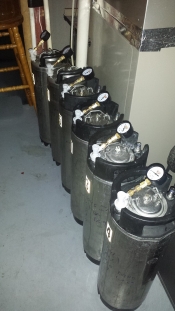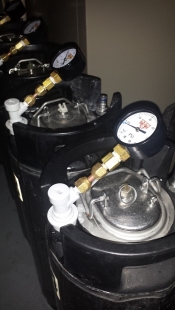Getting my keg carbonation levels right has been the least successful part of my brewing process.
I brew a lot of high gravity beers that start in the 1.095 range. They spend about 2 weeks in the primary and then if its getting dry hopped about a another 2 weeks in a secondary. If its not getting dry hopped I leave it in the primary until I get consistent gravity readings - typically about 3-4 weeks total. I then rack it to a keg and it sits in storage for between two to nine months before getting tapped. I boil between 1 oz and 3 oz of priming sugar with a little water in the microwave and add it to the keg. I have 4 primary fermenters and 5 secondary fermenters with a total of 9 kegs; 6 in storage and 3 on tap.
I used to not add any priming sugar and force carb but that shakes up any trub at the bottom of the keg and it takes a long time to settle. Most of my kegs may be well over 50 years old. I replaced all of the seals but I have tapped a few that did not seal during storage and were dead flat. Even worse, I tapped a few where the pressure was so high that it blew beer up into my gas lines. I have had a few bottle bombs back in the late 90s but I don't want to think about what a keg bomb would look like. I would guess the pressure relief valve is supposed to act as a safety but with the age of these things who knows.
I just picked up 6 pressure gauges and gas disconnects from
The Keg Connection and connection fittings from ebay. Its been a huge help. I can now see exactly how much head pressure is in each of my storage kegs at all times. If its too low I can fix a seal and or add some CO2. If its climbing up too high I just crack the relief valve and blow off some of the pressure.



It worked out to a little over twenty bucks each. Here are the parts:
Regulator Gauge 0-60
Disconnect in Gas Ball Lock 1/4 mfl
Flare Swivel Union
Flare x Female NPT
The
The Keg Connection has been great - I wonder if they would want to offer these assembled. I have seen some that have a adjustable blow off valve but they only go up to a few psi and are used for filling kegs not carbonating. It would be cool to have one that could be used to prevent over carbonating.
>-










































![Craft A Brew - Safale S-04 Dry Yeast - Fermentis - English Ale Dry Yeast - For English and American Ales and Hard Apple Ciders - Ingredients for Home Brewing - Beer Making Supplies - [1 Pack]](https://m.media-amazon.com/images/I/41fVGNh6JfL._SL500_.jpg)


















